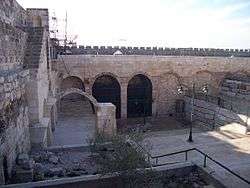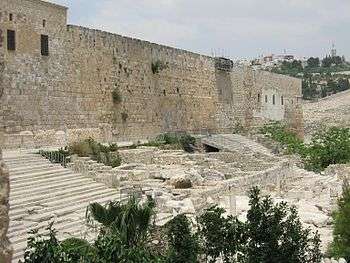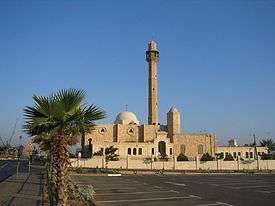Solomon's Stables

Solomon's Stables (Hebrew: אורוות שלמה) was an underground vaulted space now used as a Muslim prayer hall, some 600 square yards (500 square metres) in area, at the bottom of stairs which lead down from the al-Aqsa Mosque, under the Temple Mount, to the base of the southern wall of the Temple Mount in Jerusalem. Solomon's Stables are located under the southeastern corner of the Temple Mount, 12½ metres below the courtyard and feature twelve rows of pillars and arches. In December 1996 the Marwani Prayer Hall (Arabic: المصلى المرواني) was officially inaugurated. The Solomon's Stables no longer exist as such.
History
The structure is most widely said to have been built by King Herod as part of his extension of the platform of the Temple Mount southward onto the Ophel. The Herodian engineers constructed the enormous platform as a series of vaulted arches in order to reduce pressure on the retaining walls.[2] These vaults, "supported by eighty-eight pillars resting on massive Herodian blocks and divided into twelve rows of galleries",[3] were originally storage areas of the Second Temple. A great deal of the original interior survives in the area of the Herodian staircases, although not in the area now renovated for use as a mosque.[2] Visitors are rarely permitted to enter the areas with Herodian finishes.[2]
The underground space for the most part remained empty except for the Crusaders period.[1] The Crusaders converted it in 1099 into a stable for the cavalry. The rings for tethering horses can still be seen on some of the pillars. The structure has been called Solomon's Stables since Crusader times as a historical composite. 'Solomon's' refers to the First Temple built on the site, while the 'stables' refers to the functional usage of the space by the Crusaders in the time of Baldwin II (King of Jerusalem 1118-1131 CE).[4]
Modern construction of the El-Marwani Mosque
In the winter of 1996 the Jerusalem Islamic Waqf acquired a permit to use Solomon's Stables as an alternative place of worship on the pretext of the occasional rainy days of the holy month of Ramadan. RIvjka Gonen suggested that the real reason was that Palestinians feared that once a final arrangement with Israel is reached, Israel would create there a place of prayer. Later the waqf declared that it aimed to create a mosque for 10,000 worshippers, making it the largest mosque in the country. This move was designed to strengthen the Muslim claim over the Temple Mount.[1]

In gross violation of the status quo, the waqf began digging a huge hole in the southeastern area of the Temple Mount, without a permit from the Jerusalem municipality or archeological supervision using tractors and heavy vehicles.[1] This action drew criticism from archaeologists, who said that archaeological finds were being damaged in the process and the excavations weakened the stability of the Southern Wall. The excavations are thought to have been responsible for creating a large, visible bulge in the Southern Wall that threatened the structural integrity of the Temple Mount, necessitating major repairs.[5] The repairs have been called "unsightly" because they appear as a large, bright, white patch of smooth stones in a golden tan wall of rusticated ashlar.[5] In December 1996 the new mosque was officially inaugurated as El-Marwani Mosque.
Alternative history of Solomon's Stables
Jordanian scholar Raef Yusuf Najm suggests that the mosque was initially a water reservoir that had been built by the Roman Emperor Hadrian in the second century, along with the stone wall currently surrounding al-Aqsa Mosque. "Its overall structure closely resembles that of the Roman Ramla reservoir with stone pillars and junctions. That the reservoir was built at the same time as the wall is evident since the southern and eastern walls of the reservoir are a continuation of the wall surrounding al-Aqsa Mosque. Instead of an addition built long after the wall, the reservoir was built at the same time, as can be inferred from the joining of the stones. The reservoir was used to collect water flowing into it from surrounding areas, through horizontal aqueducts made of stone and feeding into vertical canals in the external walls of the reservoir. One of these vertical canals can still be seen today and is located at the level of the main entrance of the Marwani mosque. It is semi-circular and is lined with a Roman fuller of limestone mixed with ground clay and sand. The flooring of the reservoir is made of stone, but is covered with layers of silt that have accumulated over the years."[6]
Artifacts
The soil removed from the dig was dumped near the Mount of Olives and a salvage operation, the Temple Mount Sifting Project, was undertaken in order to sift through the debris for archaeological remains. Many important finds have turned up.[7] Israeli Antiques Authority published a report in 1999. According to this report:[1]
- 14 percent of the shards dated to the First Temple period
- 19 percent to the Second Temple period
- 6 percent to the Roman period
- 14 percent to the Byzantine period
- 15 percent to the early Muslim and medieval periods
- 32 percent could not be identified.
In a June 2000 interview with the Jerusalem Post, the chief waqf archeologist said that his colleagues examined the material taken out of the dig "either before or after the excavation" and "found nothing of special interest".[1]
References
- 1 2 3 4 5 6 Rivka Gonen (2003). Contested Holiness: Jewish, Muslim, and Christian Perspectives on the Temple Mount in Jerusalem. KTAV Publishing House, Inc. pp. 167–169. ISBN 978-0-88125-799-1.
- 1 2 3 Hershel Shanks, Jerusalem an Archaeological Biography, Random House, 1995, p. 141-15.
- ↑ Priscilla Soucek, “The Temple of Solomon in Islamic Legend and Art.” In The Temple of Solomon: Archaeological Fact and Medieval Tradition in Christian, Islamic and Jewish Art. Edited by Joseph Gutmann. Missoula, MT: Scholars Press,1976, p. 97
- ↑ Linquist, J.M., The Temple of Jerusalem, Praeger, London, 2008, p.207
- 1 2 3 "Temple Mount Repairs Leave Eyesores," Hershel Shanks, September/October 2010, Biblical Archeology Review.
- ↑ Raef Yusuf Najm, Jordan’s Role in ensuring the protection of Islamic and Christian Holy Sites in Al Quds Al Sharif, Islamic Educational, Scientific and Cultural Organization (ISESCO) conference, Amman, November 2004
- ↑ First Temple artifacts found in dirt removed from Temple Mount
External links
| Wikimedia Commons has media related to Solomon's Stables. |
Coordinates: 31°46′35″N 35°14′13″E / 31.77639°N 35.23694°E


